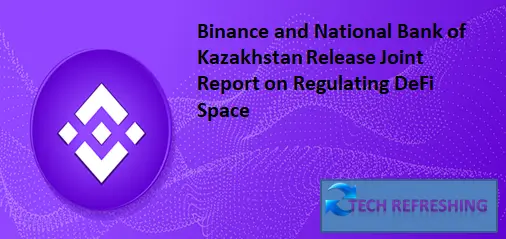Wait and See Approach Advocated, with Focus on Collaboration, Regulated Infrastructure, and Education
Binance and the National Bank of Kazakhstan have released a joint report on the state of the digital assets industry and Decentralized Finance (DeFi) in Central Asia, offering recommendations for the best approach to regulating the DeFi space. The report advocates for a “wait and see” approach, where the market is allowed to evolve on its own while regulators spend time analyzing the space and experimenting with regulations.

Collaboration between Regulators and Participants
The initial recommendation in the report emphasizes the need to enhance collaboration between regulators and participants in both traditional finance and DeFi. This would allow centralized and decentralized finance to co-exist together, as the report notes that while decentralized exchanges will become larger, many people will still prefer conventional methods of accessing their accounts.
Regulated Infrastructure
To bring CeFi and DeFi closer, the report suggests building a regulated, user-friendly infrastructure that bridges the two spheres. This infrastructure will facilitate crypto-to-fiat transactions, making it easier for users to access their accounts and manage their finances.
Regulatory Sandbox
The report also recommends building a regulatory sandbox to test and learn while running joint research and development projects to study the DeFi space. Gaining expertise in these areas will bring legal clarity to DeFi-related activities and allow for further development.
Education
Finally, the report emphasizes the importance of improving consumers’ financial and digital literacy while closing the crypto knowledge gap of lawmakers. The report argues that improving education will benefit both consumers and regulators and provide a foundation for more effective regulation.
Wait and See Approach Best Choice
The report conducted a thorough examination of different regulatory frameworks globally and grouped them into three main categories: applying traditional regulatory frameworks, composing a new framework that addresses the challenges posed by DeFi, and adopting a “wait and see” approach. The report concludes that the third option is the best choice for lawmakers at this time, as imposing regulations that are not fit for purpose will stifle innovation and a new framework for regulation is premature.
DeFi Challenges to Regulators
The DeFi space poses several challenges to regulators, including a lack of financial and digital literacy of users, regulators’ lack of crypto knowledge, irrational behavior of investors, legitimacy of data provided by oracles, lack of decentralization and financial stability risks. Additionally, there are financial, technical, and operational risks to participants, stakeholders, and the overall market, which pose various challenges to regulators, such as market manipulation, technical failures, scams, and cyber attacks.
Binance and Kazakhstan Partnership
Binance and Kazakhstan formed a partnership in mid-2022 and have since worked to contribute to the development of crypto in the region. In May 2022, Binance CEO Changpeng Zhao visited Kazakhstan to meet its President and prominent lawmakers. In October 2022, Kazakhstan began testing its Central Bank Digital Currency, Digital Tenge, on the BNB Chain.
The joint report from Binance and the National Bank of Kazakhstan provides insights into the best approach to regulating the DeFi space and highlights the importance of collaboration, regulated infrastructure, education, and a wait and see approach.


